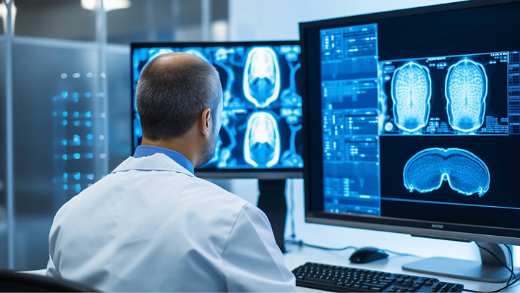Explaining PET scans and how they work
What is a PET scan

What is a PET scan?
A positron emission tomography (PET) scan produces detailed three-dimensional images of the inside of your body and is usually performed during an outpatient visit to hospital. Footnote [1] They’re different to other scans because they can show how well certain functions of your body are working rather than simply showing what they look like.
The scan detects low levels of radiation given off by radiotracer - a low level radioactive drug injected into your arm - as it collects in different areas of your body and shows abnormal areas.
Let’s say you’ve been referred for a PET scan to check for cancerous cells. Your radiographer will use the radiotracer which is very similar to naturally occurring glucose - a type of sugar - and is treated by your body in the same way. Cancerous cells use glucose at a much faster rate than normal cells and so the scan would highlight a concentration of the radiotracer if cancerous cells were present.
The PET scan helps study how active your cells are – known as ‘typical’ and ‘atypical’ metabolic activity. Atypical cell ‘hotspots’ indicate something isn’t as it should be and can then be further investigated.
Think of a PET scan as an early warning system because they can show changes in your body that other scans can’t detect.
Purpose of a PET scan
There’s a number of reasons why you might have a PET scan. It’s commonly used to help identify cancer in the body and to see if, and how far, it’s spread or whether the cancer is responding to treatment.
But it’s also used to:
- locate surgical sites and plan for operations
- identify conditions that affect the brain such as dementia, tumours, and seizures
- reveal reduced blood flow in the heart which could be an indication of heart disease
A PET scan is also used in conjunction with other types of imaging scans such as MRI (magnetic resonance imaging) known as a PET-MRI scan, or CT (computed tomography) known as PET-CT to produce even more detailed images of your body.
Preparing for a PET scan
You’ll probably have received an appointment letter with instructions on what you need to do to prepare for your scan.
Commonly you’ll be requested not to eat anything in the hours before your scan, and you may be asked to avoid strenuous exercise for 24 hours before your appointment.
You’ll have your scan in hospital and shouldn’t need to stay overnight, so you won’t need to pack a bag. It’s advisable to wear loose and comfortable clothing as you may be able to wear your own clothes during the scan rather than changing into a hospital gown.
You’ll have to remove anything metal, so avoid wearing jewellery, belts with metal buckles or any items of clothing with metal parts, such as zips.
If you’re claustrophobic (and have a fear of enclosed spaces), you may given a mild sedative before the scan to help you relax. Contact your doctor or the hospital beforehand and tell the radiographer when you arrive for your PET scan appointment.
PET scan procedure
You’ll probably be asked to arrive for your appointment about an hour before your scan as the radiotracer has to be injected into your arm and have time to collect in areas of your body. Footnote [2]
This part is quick but you’ll need to be quite relaxed and calm and avoid speaking too much as it can affect where the radiotracer goes in your body.
When you’re in the department you may be asked to visit the toilet and empty your bladder before your scan.
During the scan
During the scan you'll lay on a narrow motorised bed with a head support or straps to help keep your body in position. The bed will roll slowly into the doughnut shaped machine and the scanner will move slowly taking pictures over the part of your body that’s being scanned. You’ll need to lay really still and avoid speaking if possible so the images produced are nice and clear.
The whole process is completely painless and usually takes between thirty minutes and an hour.
After the scan
It’s really rare to experience side effects after a PET scan and you’ll be allowed to go home on the same day.
You results probably won’t be available straight away and will be instead sent for discussion with your doctor at your next appointment.
PET scan risks
You’re exposed to a small amount of radiation from the procedure, but it is very small and about the same as the amount you get from natural sources, such as the sun, over a couple of years. Footnote [3]
The word ‘radiotracer’ might sound a bit scary, but the drug carries only a small amount of radioactive fluid which becomes less radioactive as time passes. To help it pass through your body quickly and naturally you can drink plenty of fluids to flush it out of your system.
As a precaution you may be advised to avoid close contact with pregnant women, young children and babies for a few hours afterwards.
PET scan alternative
There are other scans available and your doctor will decide which one is best for you and your particular scenario:
- an MRI scan uses strong magnetic images and is often used to detect health problems such as tumours, unhealthy tissue, muscle tears and inflammation.
- you might be offered a CT scan which takes a series of X-ray pictures and is better for showing blood clots, organ injuries and bone issues.
- an ultrasound scan uses high-frequency sound waves to create images and can only be used on a small area of the body. It shows soft tissue not structures.
Use your cover to pay for your PET scan
PET scans are just one of the scans available, and if recommended by the specialist for the condition you have, then benefit may be available based on your policy terms.
If your specialist has decided to refer you for one you can get expert care by making a claim on your health insurance through MyAviva, over the phone, or online.
Once we've confirmed your claim meets the terms of your policy, we'll pay for the scan directly. It’s time for you to focus on your treatment and recovery without worrying about the fees.
It’s good to have one less thing to worry about. It takes Aviva.
Next article
Worried about GP and hospital wait times?
Here's how quickly you could get treated with health insurance.



